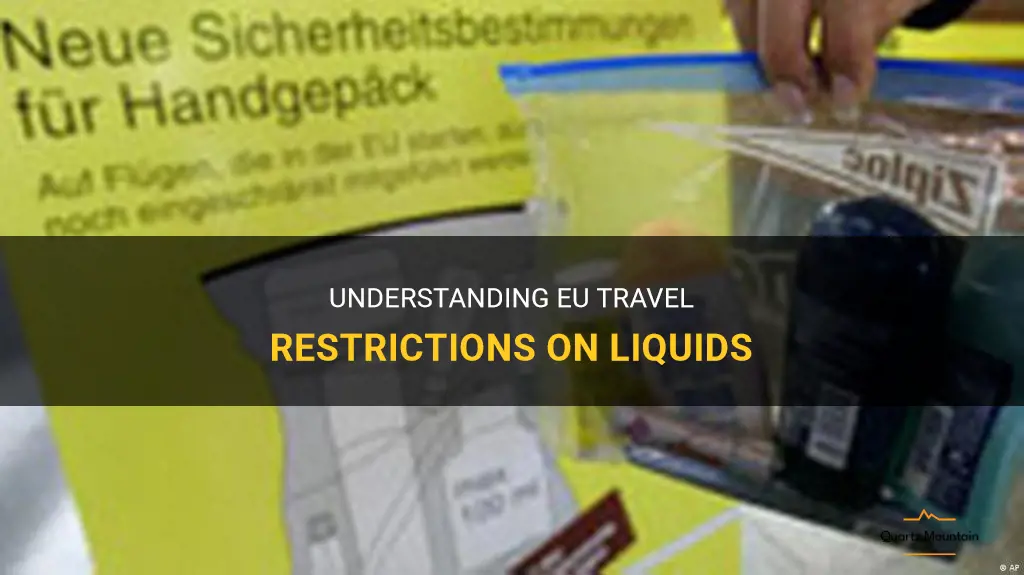
The European Union's travel restrictions on liquids have been a topic of discussion and debate since their implementation in 2006. These restrictions were put in place to increase security measures and prevent potential threats to air travel, but they have also inconvenienced and frustrated many travelers. As the EU continues to update and adjust these regulations, it is important to understand the reasoning behind them and explore alternative solutions that can balance security with convenience.
What You'll Learn
- What are the current EU travel restrictions on liquids?
- Can travelers bring any liquids in their carry-on bags on EU flights?
- Are there any exceptions to the liquid restrictions for medical or baby items?
- How much liquid can travelers bring in their checked luggage on EU flights?
- Are there any specific rules or regulations regarding the size of liquid containers for EU travel?

What are the current EU travel restrictions on liquids?
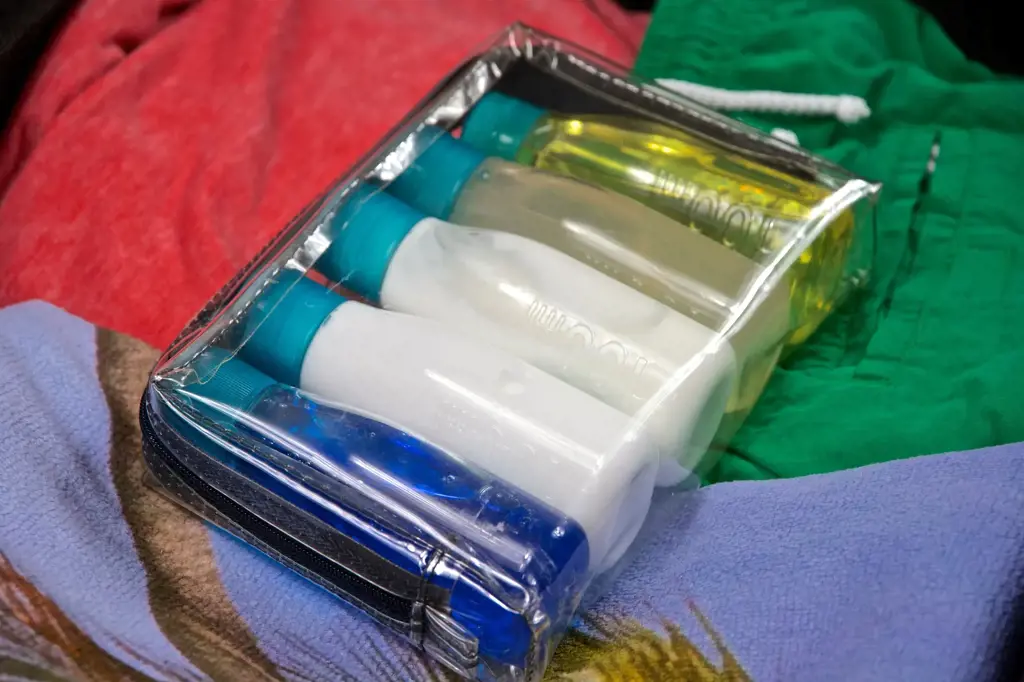
As we all know, security measures at airports have become increasingly strict in recent years, and one area that has been heavily regulated is the amount of liquids that passengers are allowed to bring on board. These restrictions were put in place to prevent the threat of liquid explosives, which were discovered in a terrorist plot in the UK in 2006.
In the European Union (EU), there are strict limits on the amount of liquids that can be brought in hand luggage. These limits apply to all passengers, regardless of their nationality or the airport they are flying from. The current EU regulations state that passengers are allowed to bring liquids in containers of 100 milliliters (ml) or less, and these containers must be placed in a clear, resealable plastic bag of a maximum capacity of one liter (1l).
This means that passengers are allowed to bring small amounts of liquids, such as toiletries and cosmetics, in their hand luggage as long as they adhere to these restrictions. The bag holding the liquids must be removed from your hand luggage and placed separately in a security tray for screening.
It is important to note that the 100ml limit applies to the container size, not the actual volume of liquid inside. So, even if you have a partially filled 200ml bottle of shampoo, you will not be allowed to bring it in your hand luggage.
There are some exceptions to these restrictions. Passengers are allowed to bring liquid medicines or special dietary requirements, such as baby food, in quantities larger than 100ml. However, these items may be subject to additional screening or verification, so it is advisable to inform the security officials beforehand.
The restrictions on liquids also apply to duty-free purchases made at EU airports. Passengers are only allowed to bring these items on board if they are packed in a tamper-evident bag with a receipt inside, and if the purchase was made on the day of travel. It is worth noting that the size restrictions still apply, so if you buy a 500ml bottle of perfume, for example, you will have to pack it in your checked luggage.
It is important to follow these restrictions when traveling to or from an EU airport, as failing to do so can result in your items being confiscated or you being delayed at security. Airlines and airport security staff are well-versed in these regulations, and they have the right to enforce them.
In conclusion, the current EU travel restrictions on liquids state that passengers are allowed to bring liquids in containers of 100ml or less, which must be placed in a clear, resealable plastic bag of one liter or less in capacity. There are exceptions for liquid medicines and special dietary requirements, but it is important to inform security officials beforehand. Duty-free purchases are allowed, but they must be packed in a tamper-evident bag with a receipt and adhere to the size restrictions. It is crucial to follow these restrictions to ensure a smooth and safe journey.
Exploring BC's Ski Resorts Amidst Travel Restrictions: What You Need to Know
You may want to see also

Can travelers bring any liquids in their carry-on bags on EU flights?
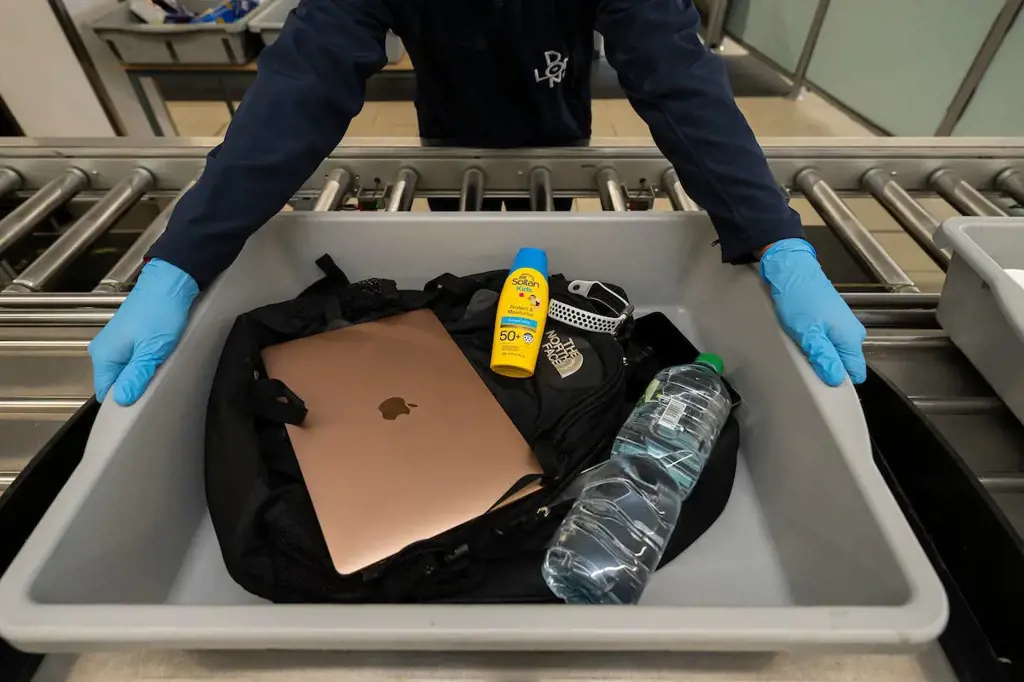
In recent years, there have been strict regulations regarding liquids in carry-on bags for airline passengers. However, the rules for European Union (EU) flights have relaxed somewhat, allowing travelers to bring certain liquids with them on board. This article will outline these regulations and provide clarity on what liquids are allowed.
The European Union follows the same basic regulations as other countries when it comes to carrying liquids in carry-on bags. Each passenger is allowed to bring a quart-sized bag of liquids, aerosols, gels, creams, and pastes in their carry-on luggage. This bag must be clear, resealable, and not exceed a capacity of 1 liter (approximately 1 quart).
In addition to the size and quantity limitations, there are also specific rules regarding each individual liquid item. These rules primarily focus on security considerations and are in place to ensure the safety of all passengers on board.
For all EU flights, liquids are permitted in carry-on bags as long as they are in containers of no more than 100 milliliters (approximately 3.4 ounces) each. These containers must be placed in the quart-sized bag described earlier and presented separately during the security screening process. It's important to note that the total volume of liquids in the bag must not exceed 1 liter.
Some common liquid items that are allowed in carry-on bags include:
- Bottled water (less than 100ml)
- Travel-sized toiletries such as shampoo, conditioner, and body wash
- Toothpaste
- Perfume or cologne in small bottles
- Lip balm or lip gloss
- Medications in liquid form (with an accompanying prescription if necessary)
- Breast milk or formula for infants (with an accompanying baby)
While these regulations apply to most liquids, there are a few exceptions. These include items like duty-free liquids purchased at the airport, which are allowed in larger quantities as long as they are sealed in a tamper-evident bag with a receipt. Additionally, liquids necessary for medical purposes, such as insulin or other essential medications, may also be exempt from the 100ml rule. However, it's always advisable to check with the airline or airport authorities ahead of time to confirm any specific requirements or restrictions.
It's worth noting that passengers traveling with liquids in their carry-on bags should be prepared for additional security screenings. These screenings may include the use of explosives trace detection equipment or physical inspection of the liquids. Passengers should also be aware that if they do not follow the regulations outlined above, their liquids may be confiscated at the security checkpoint.
In summary, travelers on EU flights can bring certain liquids in their carry-on bags as long as they comply with the size and quantity regulations. This includes placing all liquids in a clear, resealable bag with a maximum capacity of 1 liter and ensuring that each individual container does not exceed 100 milliliters. By following these guidelines, passengers can ensure a smooth and hassle-free travel experience.
Exploring Barcelona: Understanding the Current Travel Restrictions and Requirements
You may want to see also

Are there any exceptions to the liquid restrictions for medical or baby items?
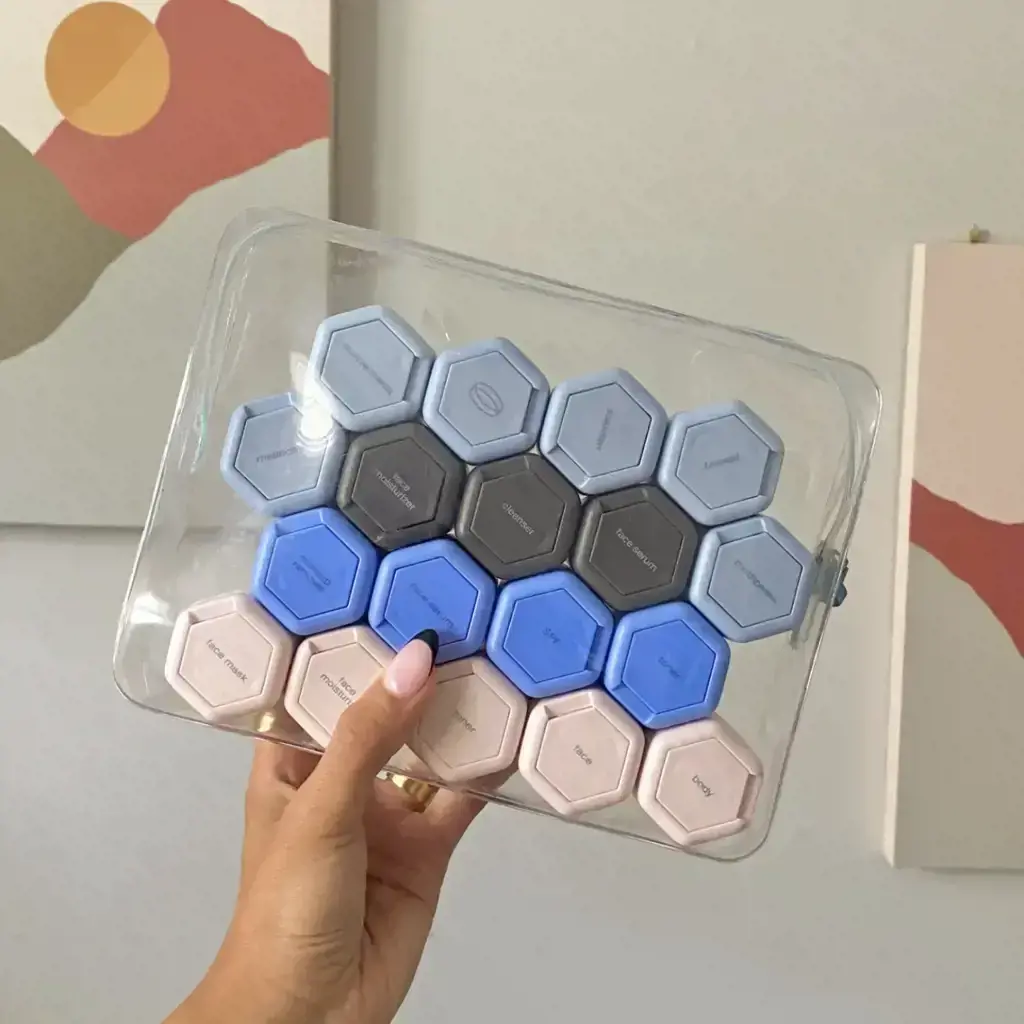
The Transportation Security Administration (TSA) has strict regulations regarding liquids in carry-on baggage. Passengers are only allowed to bring small quantities of liquids, gels, and aerosols in bottles that are no larger than 3.4 ounces (100 milliliters) per item. These containers must be placed in a clear, quart-sized plastic bag and presented separately during the security screening process.
However, there are some exceptions to these liquid restrictions when it comes to medical or baby items. Passengers with disabilities or medical conditions may bring larger amounts of liquids, gels, and aerosols in their carry-on baggage if they are necessary for their health or well-being during the flight. This includes prescription medications, over-the-counter medications, and medical supplies such as syringes, insulin, and oxygen.
In order to qualify for these exceptions, passengers must inform the security officers about their medical condition or disability at the checkpoint. It is recommended to have supporting documentation such as a doctor's note or prescription to validate the need for the larger quantities of liquid or medical items.
When it comes to baby items, parents or guardians are allowed to bring larger amounts of liquids, gels, and aerosols in their carry-on baggage if they are necessary for their child during the flight. This includes formula, breast milk, juice, and baby food. These items are not required to be in a quart-sized plastic bag but must be presented separately for screening.
Passengers with baby items should inform the security officers at the checkpoint and be prepared for additional screening. It is also recommended to have supporting documentation such as a birth certificate or passport for the child to validate the need for the baby items.
It is important to note that even though these exceptions exist, all liquids, gels, and aerosols must still be screened at the security checkpoint. Passengers should be prepared to present their medical or baby items for inspection and should allow extra time for the screening process.
In conclusion, there are exceptions to the liquid restrictions for medical or baby items. Passengers with medical conditions or disabilities may bring larger quantities of necessary liquids, gels, and aerosols. Parents or guardians traveling with infants or young children are also allowed to bring larger quantities of necessary baby items. However, it is important to inform the security officers at the checkpoint and have appropriate documentation to validate the need for these items.
Understanding Travel Restrictions in Brookings, Oregon
You may want to see also

How much liquid can travelers bring in their checked luggage on EU flights?
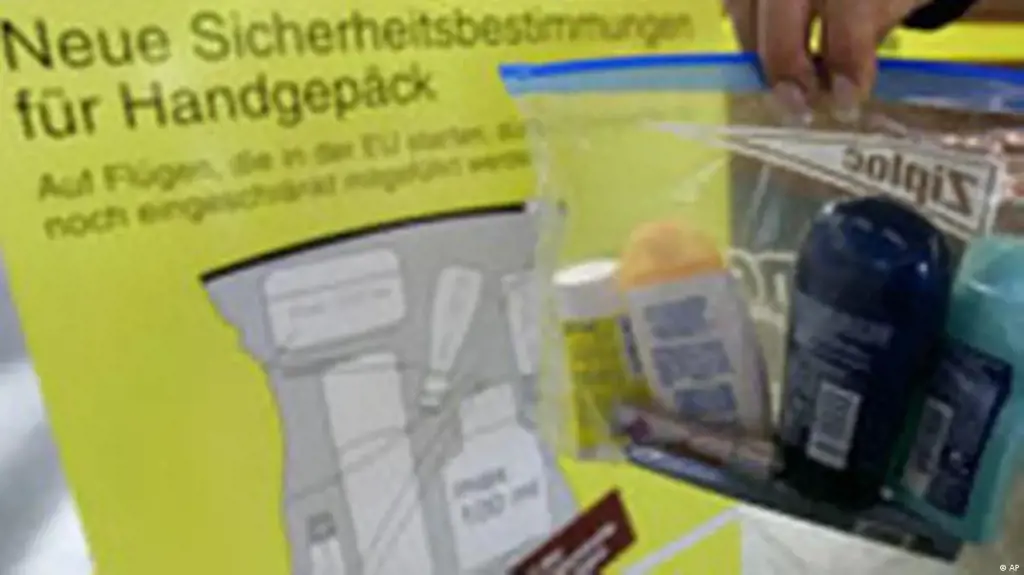
When traveling on EU flights, it is important to be aware of the restrictions on carrying liquids in your checked luggage. The regulations regarding liquids are put in place to ensure the safety of all passengers on the flight.
According to EU regulations, any liquids carried in checked baggage must be in containers with a maximum capacity of 100ml. These containers must also be placed in a clear, resealable plastic bag with a maximum capacity of 1 liter. Each passenger is allowed to carry one such bag in their checked luggage.
It is important to note that these restrictions do not apply to liquids carried in your carry-on luggage. In your carry-on, you are allowed to carry liquids in containers with a capacity of up to 100ml. These containers must also be placed in a clear, resealable plastic bag with a maximum capacity of 1 liter. Each passenger is allowed to carry one such bag in their carry-on.
If you need to carry larger amounts of liquids in your checked luggage, such as medication or baby food, you may be allowed an exception. It is advisable to contact your airline in advance to inform them about your specific needs and to check if any additional documentation is required.
It is important to pack your liquids carefully to avoid any spillages or leaks during the flight. Make sure that all lids are securely closed and that the containers are placed in a sturdy, leak-proof bag.
In conclusion, when traveling on EU flights, you are allowed to bring liquids in your checked luggage as long as they are in containers with a maximum capacity of 100ml. These containers must be placed in a clear, resealable plastic bag with a maximum capacity of 1 liter. It is advisable to check with your airline in advance if you need to carry larger amounts of liquids or have any specific requirements.

Are there any specific rules or regulations regarding the size of liquid containers for EU travel?
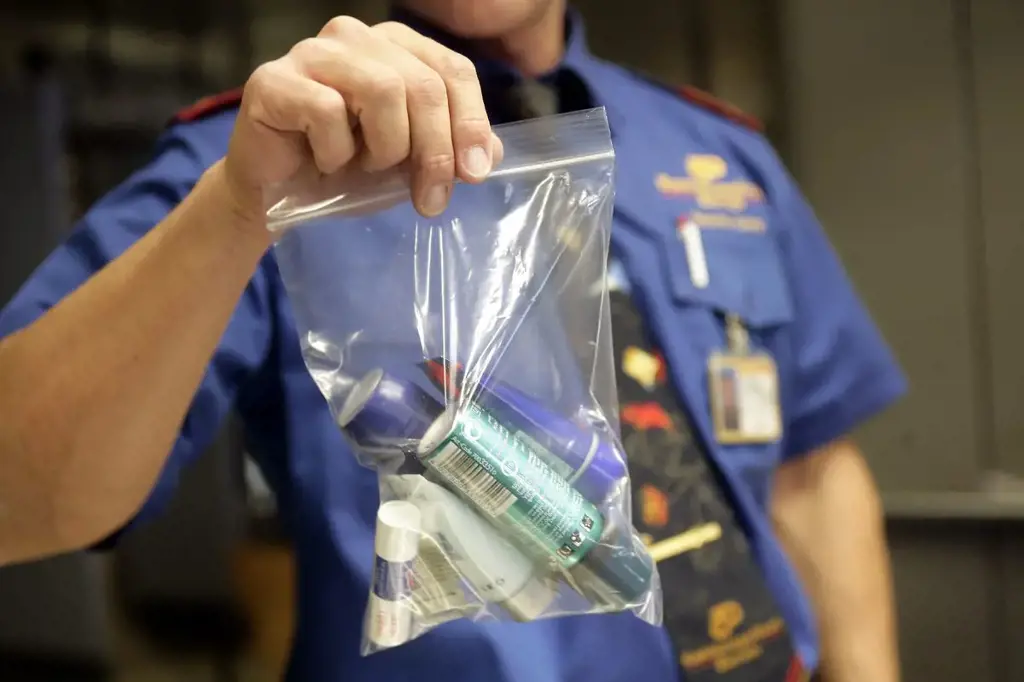
When it comes to traveling within the European Union (EU), there are specific rules and regulations regarding the size of liquid containers that you can bring with you. These rules were put in place to ensure the safety of all passengers and are applicable to both carry-on and checked baggage.
The EU's liquid restrictions follow the guidelines set by the International Civil Aviation Organization (ICAO). These rules state that liquids, aerosols, and gels must be carried in containers with a maximum capacity of 100 milliliters (ml) or 3.4 ounces (oz) each.
The containers should be placed inside a transparent, resealable plastic bag with a maximum capacity of 1 liter (40 fl oz). Each passenger is allowed one plastic bag, and it must be presented separately for screening at the security checkpoint. The bag should be able to close properly and fit all the containers comfortably.
It's important to note that the 100ml/3.4oz limit applies to the container's capacity, not the actual amount of liquid inside. This means that even if you have a small amount of liquid in a larger container, it is still not allowed.
Some common examples of items that are subject to the liquid restrictions include:
- Drinks (including water, juices, and soda)
- Perfumes and colognes
- Shampoos and conditioners
- Toothpaste
- Creams and lotions
- Gels, including hair gel and shaving gel
- Mascara and liquid eyeliners
- Contact lens solution
- Lip balm and lip gloss
- Sunscreen
- Gels used for medical or healthcare purposes
If you need to bring larger quantities of liquid for medical or special dietary needs, you may be exempt from these restrictions. However, you will need to provide supporting documentation, such as a prescription or written evidence from a medical professional.
It's important to pack your liquids properly and be aware of the restrictions before traveling within the EU. Failure to comply with these rules may result in your liquids being confiscated at the security checkpoint.
To ensure a smooth and hassle-free journey, it's always a good idea to familiarize yourself with the specific rules and regulations of the airports you will be flying from and to. Some airports may have additional restrictions or guidelines that you need to follow.
By following these guidelines, you can help ensure a safer and more efficient travel experience within the EU.
Navigating the Travel Restrictions for Canadian Forces Personnel
You may want to see also
Frequently asked questions
Yes, there are restrictions on carrying liquids in your luggage when traveling to the EU. According to the EU regulations, liquids in containers larger than 100ml are not allowed in your carry-on luggage. However, you are allowed to carry liquids in containers of up to 100ml or 3.4 ounces in your carry-on baggage. These containers must be placed in a clear, resealable plastic bag that is no larger than 1 liter in size.
Yes, you can bring larger quantities of liquids in your checked baggage. There are no specific restrictions on the quantity of liquids you can bring in your checked luggage when traveling to the EU. However, it is recommended to pack any liquids securely to avoid leaks or spillages during the journey.
Yes, there are some exceptions to the liquids restrictions. Baby food and baby milk are allowed in larger quantities, as long as they are for the baby or young child you are traveling with. Prescription medication and essential medical supplies are also exempt from the liquids restrictions. However, you may be required to provide proof of the necessity of these items.
If you try to bring prohibited liquids in your carry-on luggage, they will be confiscated at the security checkpoint. It is important to follow the liquids restrictions to avoid inconvenience and delays. If you have any liquids that are necessary for your journey, make sure to pack them in your checked baggage or follow the guidelines for carrying liquids in your carry-on baggage.







